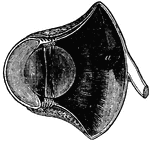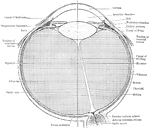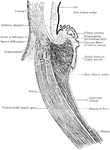Clipart tagged: ‘retina’

Detection of Astigmatism
Lines for the detection of astigmatism. "The refracting surfaces of the eye acting together are equivalent…

Cones and Rods of Retina
A. A cone and two rods from the human retina (modified from Max Schultze); B. Outer part of rod separated…
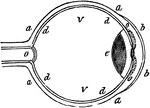
Eye
"a, sclerotic membrane; b, cornea; d, retina; o, optic nerve; v, vitreous humor." -Comstock 1850
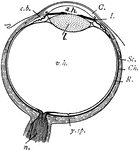
Eye
"Diagram of the eye. C., Cornea; a.h., aqueous humour; c.b., ciliary body; l., lens; I., iris; Sc.,…
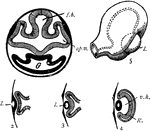
Eye Development
"Development of the eye. 1. Section through first embryonic vesicle, showing outgrowth of optic vesicles…
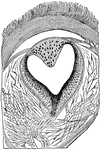
Eye of a Lizard
Longitudinal section through the pineal eye of a lizard. The eye is located in the middle of the dorsal…
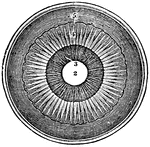
A Section of the Eye Seen from Within
A section of the eye seen from within. Labels: 1, The divided edge of the three coats. 2, The pupil.…

Cornea too Convex on Eye
"If the cornea is too convex, or prominent, the image will be formed before it reaches the retina, for…
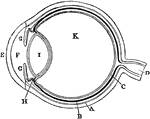
Diagram of the Eye
Plan of the eye seen in section. Labels: A, The Sclerotic Coat; B, The Choroid Coat; C, The Retina;…

Diagram of the Eye
"Diagram illustrating the Manner in which the Image of an Object is inverted on the Retina." — Blaisedell,…

Eye Focusing on Object
"Showing how the image of an object which is seen is formed on the retina of the eye." —Croft 1917
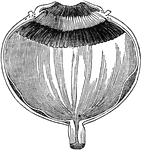
Section of the Eye
Section of the eye magnified, showing the ciliary processes, the pigmentum nigrum, the retina, and the…

Left Eyeball in Horizontal Section
The left eyeball in horizontal section from before back. Labels: 1, sclerotic; 2, junction of sclerotic…
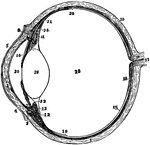
The Eyeball in Horizontal Section
The left eyeball in horizontal section from before back. Labels: 1, sclerotic; 2, junction of sclerotic…
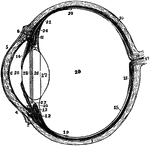
Section of Left Eyeball
The left eyeball in horizontal section from before back. Labels: 1, sclerotic; 2, junction of sclerotic…

Flattened Eye
"A representation of the manner in which the image is formed in the eye, when the cornea or crystalline…
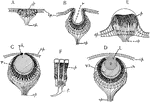
Invertebrate Simple Eye
"Diagrams showing some of the stages in the increasing complexity of the simple eye in Invertebrates.…

The Use of the Crystalline Lens
A convex lens, bends the ray of light which pass through it, so that they meet at a point called a focus.…

Eye Muscles
The muscles of the eyeball, the view being taken from the outer side of the right orbit.
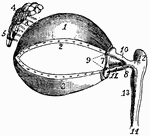
Eye Muscles
1, cartilage of the upper eyelid; 2, its lower border, showing the openings of the Meibomian glands;…

Perfect Eye
"A representation of the manner in which the image is formed upon the retina in the perfect eye. The…

Retina
"Diagram illustrating the points at which incident rays meet the retina. xx, optic axis; k, first nodal…

A Diagram of the Retina and Crystalline Lens
A diagram showing how an image is formed upon the retina by the crystalline lens.
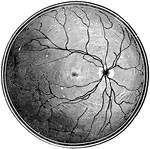
Retina Blind Spot
The right retina as it would be seen if the front part of the eyeball with the lens and vitreous humor…

Sustentacular Fibers of the Retina Fiber Basket
Diagram showing the sustentacular fibers of the retina fiber basket above the external lumbar membrane;…

The Position of the Retina in Near and Far Sight
A flattened shape of the globe of the eye causes farsightedness and an elongated shape of the globe…

Section of Retina
A section through the retina from it anterior inner surface (1) in contact with the hyaloid membrane,…
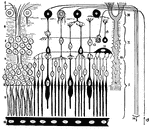
Eye Retina
Diagram of the retina, aka percipient layer of the eye. 1: inner limiting membrane, which is next to…

Layers of the Retina
Section through the macula lutea and fovea centralis of the human retina. Labels: a, fovea; b, descent…

Nervous Elements of the Retina
Diagram showing the nervous elements of retina. Labels: 1, nerve fiber to ganglion cell; 2, processes…

Neurons and Sensory Epithelium in the Retina
Diagram showing relations of the neurons and sensory epithelium in the retina. labels: E, epithelial…
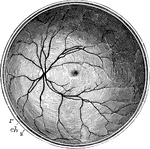
Posterior Half of the Retina
The posterior half of the retina of the left eye, viewed from before; s, the cut edge of the sclerotic…

Section of Retina
Perpendicular section of mammalian retina. Labels: A, layer of rods and cones; B, outer nuclear layer;…
The Structure of the Retina
Next to the choroid and comprising about 1/4 the entire thickness of the retina is a multitude of transparent,…

Structure of the Retina
A section of the retina, choroid, and part of the sclerotic. Labels: a, membrana limitans interna; b,…

Retinal Structure
Diagram of the structure of the human retina. Labels: I, pigment layer; II, rod and cone layer; R, rods;…

Vertebrate Eye
"Diagrams illustrating two stages in the development of the vertebrate eye. A, showing the relation…

